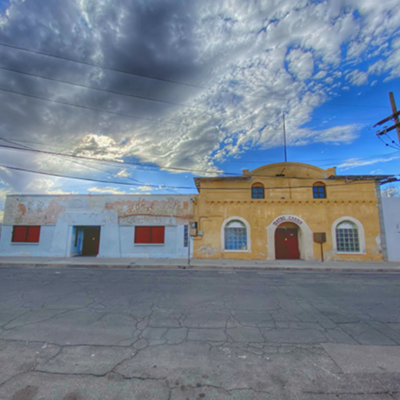On most days, the International Wildlife Museum sees a steady stream of visitors, drawn by coy marketing or morbid curiosity to this peculiar citadel in the Tucson Mountains west of town.
That was even more the case one crisp Saturday in mid-February, as the museum auspiciously celebrated its 25th anniversary with jaunty food trucks and a big birthday cake.
It was a notable achievement for a once-controversial institution, born amid protests over its inventory of dead animals and homage to the hunters who killed them.
But time waits for no crusade. Passions fade, as does memory. Yet the museum remains, stalwart in its hillside lair. Today, there seems nothing fragile about this edifice, constructed to resemble a French Foreign Legion post in Africa. You could even consider the design itself an architectural conceit, exalting those globe-trotting, well-heeled, big-game hunters of Safari Club International.
After all, it was the high-caliber gentlemen of the Safari Club who founded this museum and stocked its halls with their trophies. And it is their political pull that still marches forth, from the club's headquarters right next door.
From here, the organization directs its campaigns to weaken the federal Endangered Species Act, to maximize hunting and motorized access across public lands, and to eliminate restrictions on the importation of trophies shot in foreign countries. Most recently, club officials showed up in court to urge the removal of polar bears from the federal list of threatened species.
In another case, the club challenged a federal court mandate that the U.S. Fish and Wildlife Service finally decide about extending protection to more than 750 dwindling species. Many of those creatures have lingered in limbo for years; some have since gone extinct.
In opposing the ruling, the Safari Club had hoped to retain hunting rights for at least three species, including the increasingly rare New England cottontail rabbit.
But you won't learn much about this agenda from a tour of the International Wildlife Museum. Nor is such information shared on the museum's website, which instead explains that its approximately 400 stuffed critters were donated by "various government agencies, wildlife rehabilitation centers, captive breeding programs, zoos and individuals."
In truth, the lion's share arrived via a clean shot, many of them delivered from the business end of SCI founder C.J. McElroy's top-notch rifle.
"Originally, most of them were legally hunted by hunters, primarily McElroy," says museum director Richard White. "These days we get them from fish and game agencies; we get them from hunters, or zoos where they have an animal that dies."
It also appears that the Safari Club and its museum get a lot more than road kill from state agencies such as the Arizona Game and Fish Department. Their ties seem to run deep on everything from endangered species policy to the sponsorship of youth hunting programs.
The evening after the Game and Fish Commission's March meeting in Sahuarita, for instance, the Safari Club hosted a commission junket to a youth hunting camp west of town. Participation in the camp was limited to kids registered through the club.
Pushing its agenda through ties with state officials is a time-honored Safari Club strategy, says Patrick Parenteau, an expert on wildlife protection policy at the Vermont Law School in South Royalton, Vt. "They have connections to the state departments of wildlife, because those departments have a vested interest in recreational hunting. They exert lot of influence behind the scenes."
That sway is largely targeted at constraining the Endangered Species Act, Parenteau says. "They're a user group and their concern is that the act restricts their ability to hunt and kill species, particularly charismatic mega-fauna."
Meaning big, fascinating animals such as wolves and polar bears. "Their mission is to maintain hunt-able populations of every species on Earth," Parenteau says, "and to challenge anyone who suggests that they shouldn't be hunted."
Neither Safari Club executive director Phil DeLone nor deputy director Nelson Freeman returned phone calls seeking comment.
But museum director White argues that the Safari Club is really all about protecting animals.
"We are conservationists as much as anybody else," he says. "You can't have sustainable use of animals if they're all killed off. That is why we do so much in the conservation arena."
The term "conservation" does see plenty of action in Safari Club promotional materials. On the website, for example, you'll find a tab saying "Click here to help save lions."
Make that click, and you're taken to this less-than-tender plea: "What do deer and lions have in common? The antis want to stop the hunting of them and everything else.
"This year the antis are out to stop hunting of African lions," it continues. "Is the whitetail deer next? Your donation to the African Lion Defense Fund helps SCI take the fight against the global assault on hunting to Africa and stop it there before it spreads worldwide."
Conservation at its finest? Samantha Hagio thinks not. She's wildlife protection policy manager for the Humane Society of the United States in Washington, D.C. "Rather than direct their conservation efforts to truly conserve the species, (the Safari Club) fought the listing of the polar bear on the endangered species list and would prefer to hunt them instead," she writes in an email to the Weekly.
"They have also been large proponents of hunting three endangered antelope species—the dama gazelle, scimitar-horned oryx, and the addax—on captive hunting ranches, fenced enclosures where animals are stocked and shot for guaranteed trophies. These ... antelope are considered critically endangered in their native habitat, and the scimitar-horned oryx is actually considered extinct in the wild."
The Tucson-based Center for Biological Diversity recently had its own court dust-up with the Safari Club, after club lawyers appealed that decision forcing the Fish and Wildlife Service to decide the fate of 700-plus species. The ruling had resulted from lawsuits by the center and WildEarth Guardians.
The Safari Club opposed that ruling "because they want to hunt some of those species," says center executive director Kieran Suckling.
As stated in court, the club's desired prey included the greater sage grouse, the lesser prairie chicken and the New England cottontail rabbit. To Suckling, even mentioning the cottontail reveals just how much ideology trumps common sense in the Safari Club's alternate universe. "There are rabbits all over the country and they want to hunt the one species that's down to 300 animals," he says. "No one has hunted this rabbit in decades; no one has even seen this rabbit, it's so rare.
"This isn't really a hunting issue at all," Suckling says. "To the extent that they can use hunting interests as an excuse to scuttle endangered species protection, that's what is going on."






